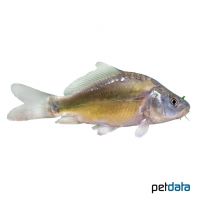Mirror Carp (Cyprinus carpio)
| Mirror Carp Cyprinus carpio | |
|---|---|
| Name | Mirror Carp |
| Name Lat. | Cyprinus carpio |
| Family | Carps |
| Family lat. | Cyprinidae |
| Order | Carps |
| Order lat. | Cypriniformes |
| Origin | Europe, Asia |
| Habitat | Rivers, lakes, ponds |
| Diet | Omnivore |
| pH | 6.5-7.5 |
| Behavior | Peaceful |
| Keeping | Group |
| Care Level | Easy |
| Reproduction | Egg scatterer |
| Breeding | Moderately difficult |
| Life Span | 20-40 years |
| Protection | No |
| Metric Units | |
| Size | 30-50 cm |
| Temperature | 4-28 °C |
| Hardness | 10-15 °dH |
| Aquarium | Ponds |
| US Units | |
| Size | 12"-20" |
| Temperature | 39-82 °F |
| Hardness | 178-267 ppm |
| Aquarium | Ponds |
Distribution and habitat
Mirror carp is a farmed form with significantly enlarged scales distributed over the entire body. The carp originate from the tributaries of the Black and Caspian Seas and have been spread by humans throughout Europe, except Scandinavia, since ancient times. They live in stagnant and slow-flowing waters rich in plants.
Maintenance
The pond should be furnished with pond, floating and oxygenating underwater plants (milfoil, waterweed, hornwort, etc.), large river pebbles, and a substrate of round-grained gravel and sand suitable for burrowing, and provide plenty of free swimming space.
No ammonia, ammonium and nitrite should be detectable, the nitrate value should not exceed 100 mg/l. To ensure the water quality and oxygen content, a filter adapted to the water volume should not be missing.
Diet
The feed offer consists mainly of commercially available special dry feed for carp with medium protein content (flakes, sticks, granules). In addition, vegetable food such as aquatic plants (e.g. Rizzia flutians), over-broken leaves (e.g. dandelion, lettuce, cabbage) or dry food with a particularly high vegetable content (spirulina) can be offered, as well as animal food such as daphnia, mosquito larvae, tubifex, earthworms, snails, mussels, etc. or alternatively a frozen special food mix.
Only feed as much as will be eaten in a few minutes. Regular and varied feeding promotes health and increases resistance.
Behaviour and compatibility
They are calm, peaceful and sociable fish that do not show any aggressive or incompatible behavior. At least 5, but preferably more carps should be kept together
Basically, only compatible fish species with similar demands on water quality and water temperature may be socialized.
Reproduction and breeding
The sexes are difficult to distinguish, males are slightly more slender and have a faint spawning rash at mating time.
Between May and June, at a water temperature of at least 15 °C, females spawn in the shallow shore zone, where the eggs adhere to plants. After 5 days, the larvae hatch and attach to aquatic plants for another 3 days before coming to the water surface to fill their swim bladder with air. Life expectancy can be over 15 years.
Important
Besides the mirror carp, there are other breeding forms, such as the scaled carp, the line carp with only one or more rows of scales, and the unscaled or with few scales leather carp.
If carp are overwintered in the pond, sufficient depth and oxygen supply (filter, oxygen dispenser, ice free holder) must be provided
At temperatures below 8-10 °C the metabolism of the fish slows down and food is no longer accepted, accordingly feeding must be stopped. If the temperature drops further, they hibernate near the bottom. In spring, with rising temperatures, feeding can slowly be resumed. Feeding may also be necessary during prolonged warm periods in winter.
The well-being of the fish should be monitored regularly. A regular partial water change, according to the pond size is recommended, even if the pollutant load has not yet reached the upper limit. Sudden changes in water quality should be avoided. Newly introduced fish must be accustomed slowly to the water in the pond
Further literature can be found in your pet store.
References
Text: Werner Winter; Image: petdata
Source: BMELV (1998): Tierschutzgutachten - Haltung von Zierfischen (Süßwasser); RIEHL & BAENSCH (2006): Aquarien Atlas Bd. 1, Mergus Verlag; ENGELMANN (2005): Zootierhaltung - Tiere in menschlicher Obhut: Fische; Harri Deutsch Verlag
- Gemäß § 21 Abs. 5 Tierschutzgesetz idgF
